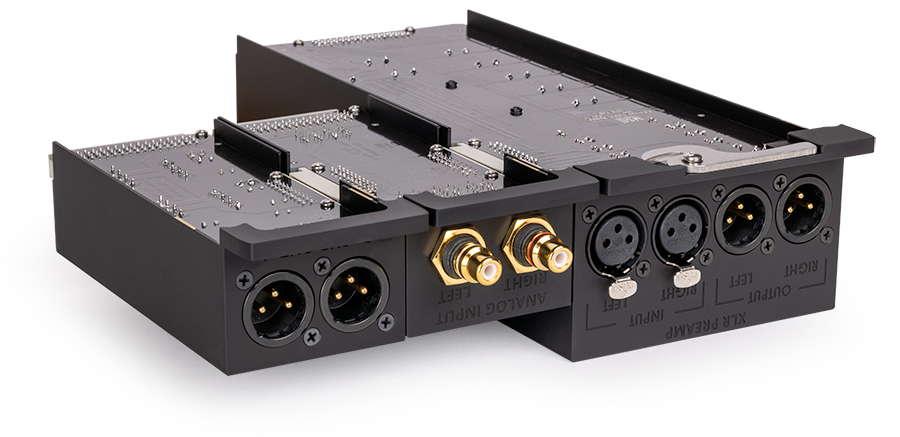Output Modules

Output stages of our DACs
The output stage of any DAC can have a large influence on its sound quality. The output stage must translate the signals generated by the D/A circuit into signals compatible with connected amplifiers. This process is ideally without much signal loss, coloration, contamination or degradation. Most D/A circuits have feeble outputs, which must be amplified or buffered in order to successfully navigate the outside world. This amplification or buffering usually results in at least some degradation of sound quality, as the signal is recreated by the active circuitry. This explains why there are thousands of driver circuits to choose from; each one has a different weakness.
What’s unique about our D/A modules is we create a robust high-power signal that doesn’t need any further amplification or buffering to drive any external load. In all of our DACs, there isn’t active circuitry from the conversion point to the connector on the back. No op-amps, no transistors, no tubes…
Our DACs have two basic output types: the “Base Output” and the “Preamp Output”
Each interface has advantages and disadvantages. Each interface is covered below:
Base Output Stage:
(Standard for the Discrete DAC and Premier DAC)
The Base Output stage has two output levels to choose from: high and low. These settings help match the DAC with the amplifier or preamplifier. If our DAC is used directly with an amplifier, an included proprietary ultra-low loss digital volume algorithm is used. Since digital volume control has some loss at lower volume settings, it’s best to match the gain in the system to keep the ideal listening level at a relatively high volume setting. If an external preamp is used, the digital volume control can be completely disabled and bypassed.


Preamp Output Stage:
(Standard for the Reference DAC and the Select DAC)
When our advanced constant impedance preamp stage is used, the volume level is completely controlled with passive components, without the aid of any digital volume control. The D/As convert at full level while the preamp stage reduces the output in addition to maintaining a constant output impedance. This technology is utilized without the use of any active circuitry in the DACs output. It’s our philosophy that the best thing you can do to analog audio is nothing. A preamp should be as neutral as possible and should not color the sound in any way. When our Preamp module is used, you get the full quality of the DAC without anything added or removed. The output is pure.


(Single-ended option for Reference DAC and the Select DAC)
We use external transformers to properly convert a balanced signal to a single-ended output. Transformers can add unwanted magnetic and sonic variations to the sensitive analog components in the output stage of a DAC. Having these transformers in close proximity can also add to unwanted signal cross-talk. This is why we have moved the conversion away from the output stage of the DAC and into a sleek inline unit. Now the signal of your DAC can stay balanced until it is ready to be converted closer to the amplifier and farther from the sensitive analog circuitry of your DAC and preamp.

Analog Expansion Modules
Analog expansion modules are only an option for Preamp output modules that are available for the Select and Reference series. Analog expansion modules allow you to add additional analog inputs and isolated subwoofer outputs.

Additional Analog Inputs
These are available as XLR or RCA specific modules.
They provide an additional XLR/RCA Analog Input. This module is ideal for passing a secondary external analog source through your DAC. The analog inputs allow you to use the volume control of your preamp module to passively attenuate the signal or directly bypass your DACs output circuitry for a simple and unaltered method of adding an additional analog source to your amplifiers.
The DAC can support multiple analog input modules.
Isolated Sub-woofer Outputs
These are available as XLR or RCA specific modules.
This module provides a fully isolated XLR/RCA output for use with a powered sub. The Sub Isolator acts as a barrier for the delicate mid to high frequency ranges between your loudspeakers and powered sub.
Only one extra output* option can be used per DAC.
*Isolated Analog Output or Isolated Subwoofer Output

The Sub-Isolator
This module provides a fully isolated XLR/RCA output for use with a powered sub. The Sub isolator acts as a barrier for the delicate mid to high frequency ranges between you loudspeakers and a powered sub.
The Sub Isolator is available in balanced and single-ended versions. It is intended to be used with any product that is not equipped with a Select or Reference Preamp module.

